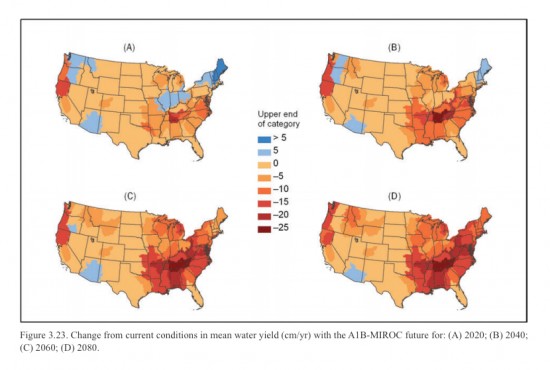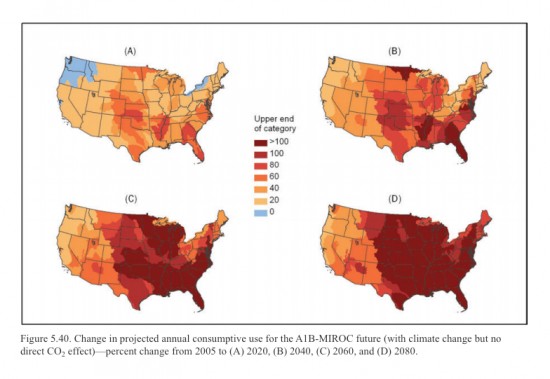Climate Change May Dry Up Important U.S. Reservoirs Like Lake Powell And Lake Mead
 As climate change makes the regions of the West, Southwest, and Great Plains warmer and drier, water demand will continue to increase, and the combined effect will place an ever greater burden on the country’s fresh water supplies — possibly completely draining important reservoirs in those areas, under some scenarios. That’s according to a new study authored by researchers with Colorado State University, Princeton and the U.S. Forest Service, and flagged yesterday by Summit County Citizens Voice.
As climate change makes the regions of the West, Southwest, and Great Plains warmer and drier, water demand will continue to increase, and the combined effect will place an ever greater burden on the country’s fresh water supplies — possibly completely draining important reservoirs in those areas, under some scenarios. That’s according to a new study authored by researchers with Colorado State University, Princeton and the U.S. Forest Service, and flagged yesterday by Summit County Citizens Voice.This is consistent with other studies on the risk of future water shortages: The Department of the Interior is anticipating that by 2060 the gap between river supply and water demand in the states of the Colorado River Basin will be 3.2 million acre feet due to climate change. Research published in Environmental Science and Technology found that by 2050 one third of U.S. counties could face “high” or “extreme” risk of water shortage. And the International Energy Agency determined that if current policies remain in place, fresh water use by the energy industry alone could more than double — from 66 to 135 billion cubic meters annually by 2035.
Climate change, substantially driven by global warming and humanity’s carbon emissions, is anticipated to lead to more weather extremes in various areas — longer periods of low precipitation and water shortage in many areas, interspersed with greater deluges. And, of course, higher average temperatures to bake the same regions as they dry out. The Forest Service study used a number of different scenarios in its models, assuming different levels of future population growth, economic growth, and temperature increases:
Future climate change will increase water use for agricultural irrigation and landscape maintenance in response to rising plant water requirements, and at thermoelectric plants to accommodate rising electricity demands for space cooling. Including these effects, per-capita withdrawals are projected to drop only moderately for the next few decades and then level off as the effects of climate change become greater, and total withdrawals are projected to rise nearly continuously into the future. Projected withdrawals differ across the global emissions scenarios examined, especially in the latter decades of the century.
Although precipitation is projected to increase in much of the United States with future climate change, in most locations that additional precipitation will merely accommodate rising evapotranspiration demand in response to temperature increases. Where the effect of rising evapotranspiration exceeds the effect of increasing precipitation, and where precipitation actually declines, as is likely in parts of the Southwest, water yields are projected to decline. For the United States as a whole, the declines are substantial, exceeding 30% of current levels by 2080 for some scenarios examined.
Here’s just one example of several permutations the study did, laying out the changes in future water yields in 2020, 2040, 2060 and 2080. The A1B scenarios were relatively middle-of-the-road, assuming medium population growth, high economic growth, and medium temperature increases in the future:

And here’s the projected changes in annual water consumption under that same permutation, accounting for the effects of climate change:

In some key areas, including the Southwest, parts of California, and the central and southern Great Plains, “important reservoirs are left with little or no water” in some scenarios. In the Colorado River Basin, for instance, “Lakes Powell and Mead are projected to drop to zero and only occasionally thereafter add rather small amounts of storage before emptying again.”
In many ways the problem is already beginning to bite. It looks like the historic droughts that have wracked the West, the Southwest and the Plains areas for the last two years may very well continue through the spring and summer. And Texas and Oklahoma, plus Texas and New Mexico, are involved in suits over rights to water use and river flows — with the latter dispute scheduled to go all the way to the Supreme Court.
“We were surprised to find that climate change is likely to have a much greater effect on future water demands than population growth,” Forest Service research economist Tom Brown, who led the study along with CSU’s Jorge A. Ramirez, told Summit County Citizens Voice. “The combined effects of climate change on water supply and demand could lead to serious water shortages in some regions.”
You can return to the main Market News page, or press the Back button on your browser.

